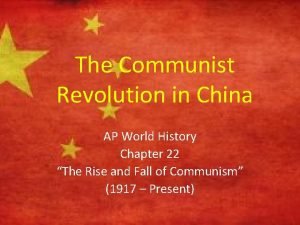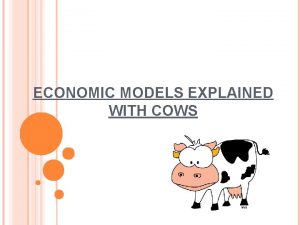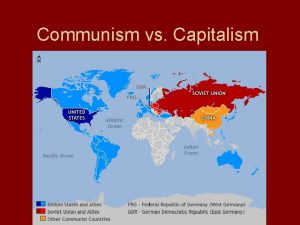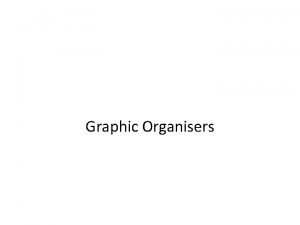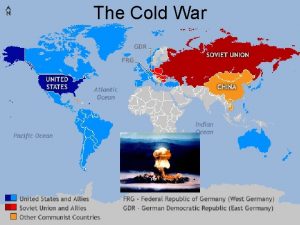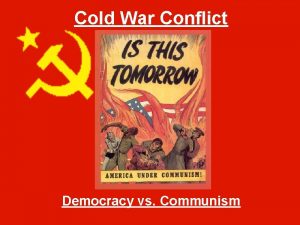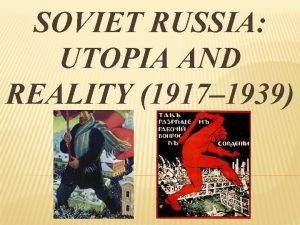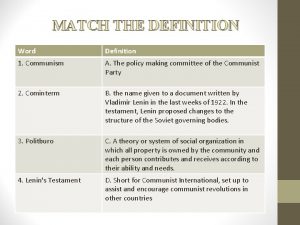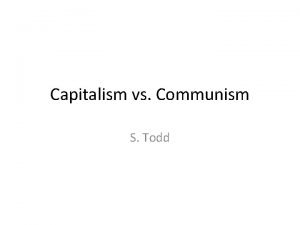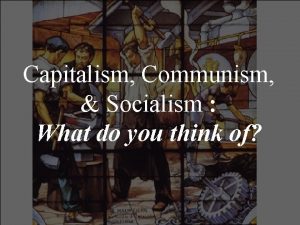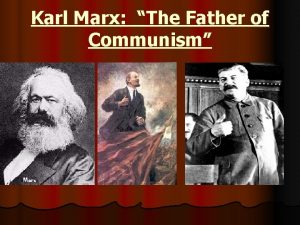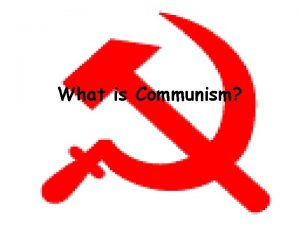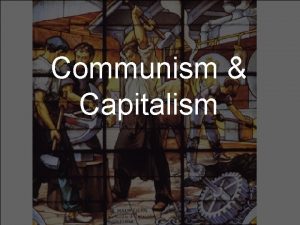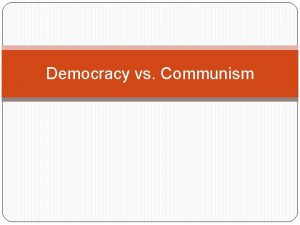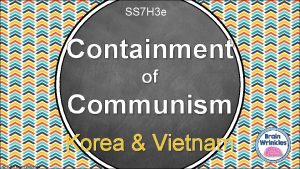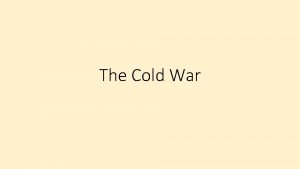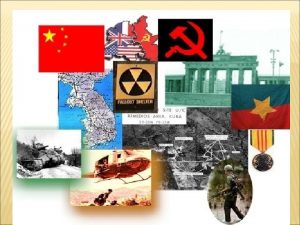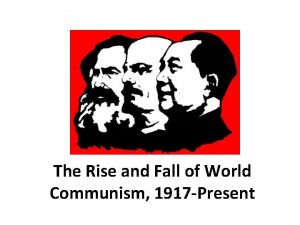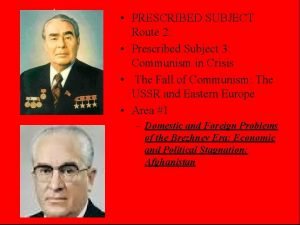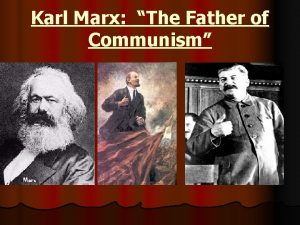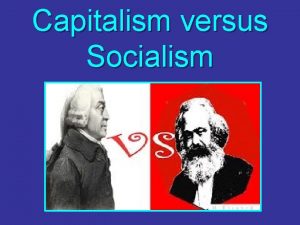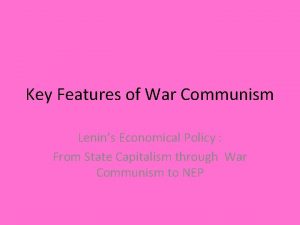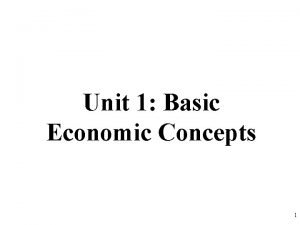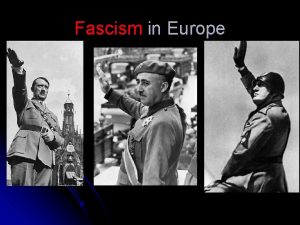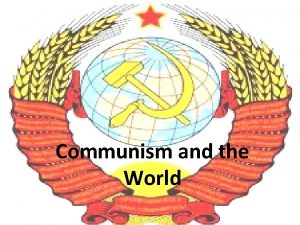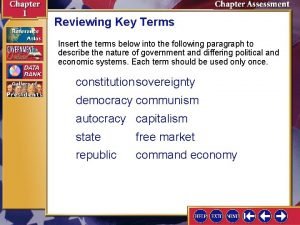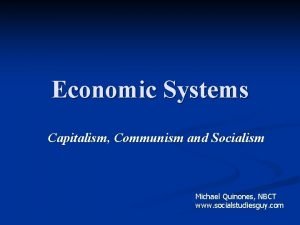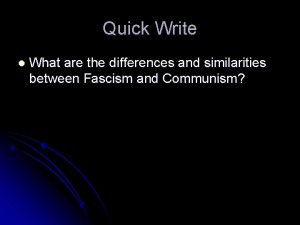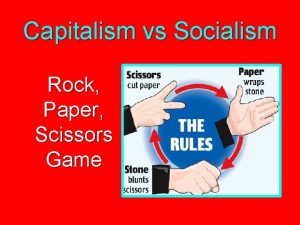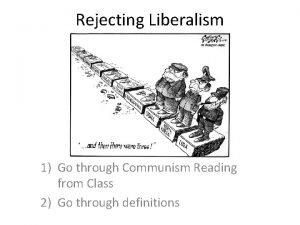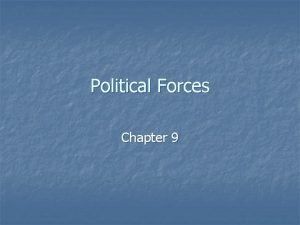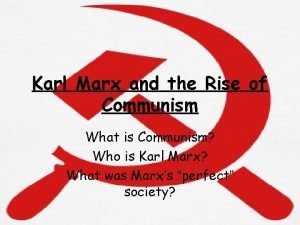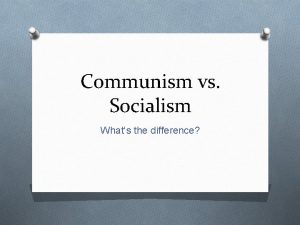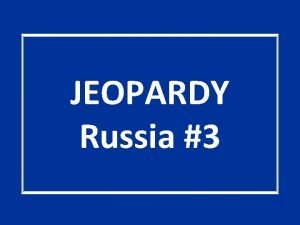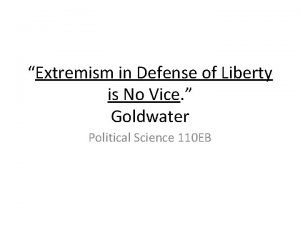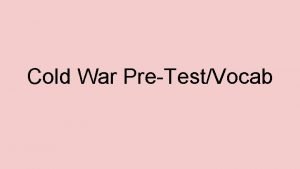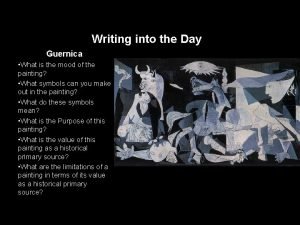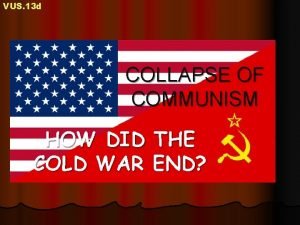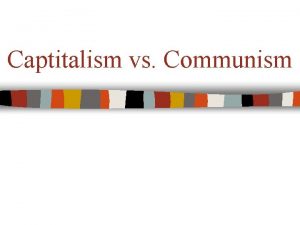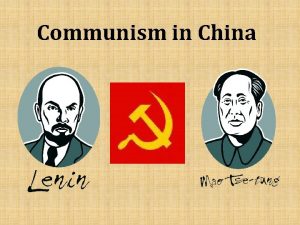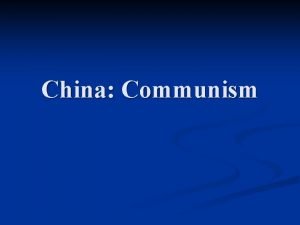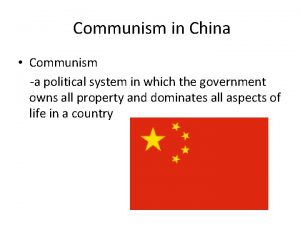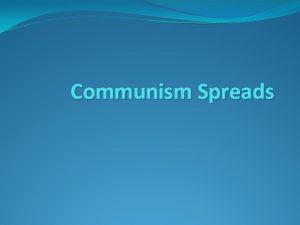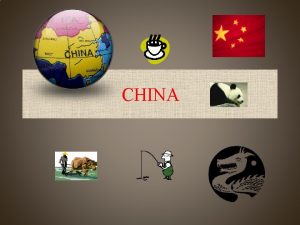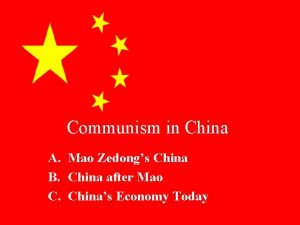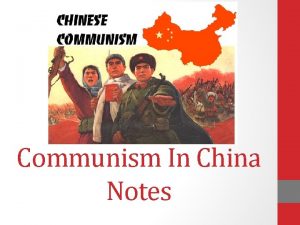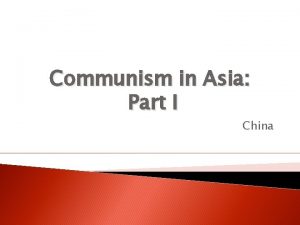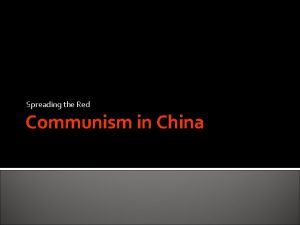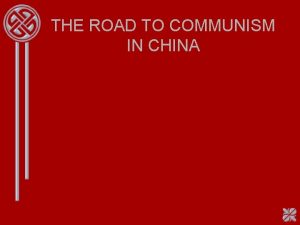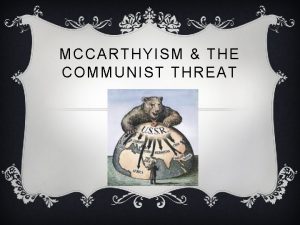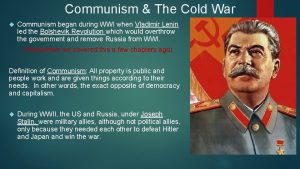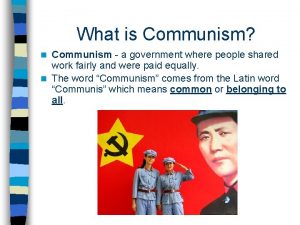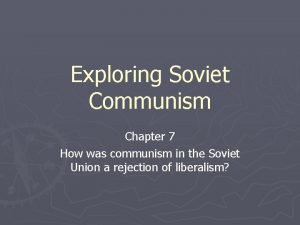The Road to Communism China in the 20













































- Slides: 45

The Road to Communism: China in the 20 th Century

The End of Imperial China In 1912 the last Chinese dynasty (monarch or emperor), the Qing Dynasty, led by a child emperor, abdicated the throne, and the country was quickly taken control by warlords.

Chinese Warlords: 1920 s

Chinese Warlords: 1920 s Warlords (or military leaders) took control of sections of the country and fought to gain more territory or hold on to the territory they had established. Warlords Video 2: 49 – 4: 30 Yuan Shi-kai

Nationalists and Warlords Nationalists (those who wanted to unit China under one leader or system of government) believed that the warlords system was weakening China and making the country vulnerable to foreign invasion. Sun Yat-sen helped establish the Chinese Nationalist Party or the Kuomintang (KMT).

The Beginning of the CCP (Chinese Communist Party) In 1919, a group of students led the May Fourth Movement which was a nationalist protest against foreign influence. This protest helped begin the Chinese Communist Party by bringing together young revolutionaries such as Mao Zedong (also spelled Mao Tse-tung) who was the founder of the CCP. (Mao Tse-tung)

Attacks from the KMT From the beginning of the CCP, they worked together with the KMT. . both wanting a unified China. However, Chiang Kaishek, the leader of the KMT began ordering the purging of communists out of the KMT. The Shanghai Massacre on April 12 th of 1925 killed over 5, 000 communist party members. Communist Purge Video 15: 33 – 19: 30

Chaing Kai-shek Becomes President of Nationalist China: 1928 By 1928, the KMT had united China under one government and Chiang Kai-shek ruled as dictator. (Chiang Kai-shek) Mao Overview Video 25: 16 – 31: 51

For eight years the CCP attempted to fight the KMT forces. However, in 1934 the CCP retreats 6, 000 miles while being chased by the KMT. 87, 000 of the CCP begin the journey, 5, 000 remain by the end. The group traveled an average of 17 miles a day. One year later, the CCP is almost completely defeated. Long March Video 38: 00 – 45: 30

Japanese Aggression (WWII) 1937 1945 During WWII Imperialist Japan began expanding territory throughout the Pacific including mainland China. In 1937 Japanese forces invade the major Chinese cities of Peking, Shanghai and Nanking. The Rape of Nanking, as it became known as, was a horrendous attack on not only KMT forces, but also women and children.

Japanese Invasion of China during WWII Top left: remains of civilians during the bombing of Shanghai. Above: baby cries at a bombed train station. Left: Chinese soldiers were decapitated and their heads placed on public display.

Japanese Invasion of China during WWII remains of children bayonetted by Japanese soldiers. public beheading of Chinese man by Japanese soldiers.

The Communist Victory Nearly defeated after the Long March, Chinese Communists unite with the KMT to fight the Japanese. By the end of WWII in 1945, the Communists had gained popular peasant support and now outnumbered the KMT forces. They renew the Chinese Civil War against the KMT.

The Peoples’ Liberation Army (CCP) and the Kuomintang Renew the Civil War (1945 -1949) The CCP was supplied and supported by the Soviet Union while the KMT was supplied and supported by the United States and other democratic nations. By 1949, the KMT is driven off of mainland China onto the island of Taiwan (the Republic of China) and the rest of China becomes the communist People’s Republic of China. Mao becomes the first Chairman of the People’s Republic of China.

Reasons for the Communist Victory ► Mao won support of the peasants (land redistribution, overthrow of the upper classes) ► Mao won support of women (communists viewed women as equal; end to foot binding) ► Mao’s army used guerilla war tactics ► Many saw the Nationalist government as corrupt (and a dictatorship) ► Many felt that the Nationalists allowed foreigners (U. S. , British) to dominate China.

1956: The Hundred Flowers Campaign is launched. Mao encourages the people to voice their complaints about CCP policies. Mao quickly stops the movement and begins to use the information gathered to purge the nation of “counterrevolutionaries” or “reactionaries. ”

The Great Leap Forward: 1958 - 1961 Citizens are forced to give up any metals they own (pots, pans, utensils, etc. ) to melt down into steel and other metals for industrial production. Backyard furnaces are kept burning in towns throughout China.

The Great Leap Forward: 1958 - 1961 A five year plan to increase agricultural and industrial production. Peasants were reorganized into huge collective farms. The workers were required to meet quotas. The Great Leap Forward Video 36: 42 – 58: 20 An estimated 40 million died during a manmade famine created by The Great Leap Forward

The Cultural Revolution: 1966 -1976 ► Designed to renew revolutionary spirit and establish a more equitable society ► Mao wanted to put “intellectuals” in their place ► Schools shut down – students revolted ► Red Guards – students who attacked professors, doctors, government officials, factory managers

The Great Proletarian Cultural Revolution: 1966 - 1976 Red Guards roamed cities and villages rounding up anyone with “status” (professors, doctors, teachers, etc. ), labeling them “reactionaries, ” or “capitalists. ” Most of them are killed. It is estimated that 10 million citizens are killed.

A Campaign Against the “FOUR OLDS” ► Old Thoughts ► Old Culture ► Old Customs ► Old Habits To Rebel Is Good!

The Great Proletarian Cultural Revolution: 1966 - 1976 The Little Red Book (or Quotations From Chairman Mao) Red Guards carried quotations from Mao that they would read during free time or use to chant together as a group. Signs with his quotations were made and placed throughout public spaces.

“A revolution is not a dinner party, or writing an essay, or painting a picture, or doing embroidery. . . A revolution is an insurrection, an act of violence by which one class overthrows another. ” ~ Mao Tse-Tung

The Great Proletarian Cultural Revolution: 1966 - 1976 Those with “status” being named “counterrevolutionaries” and eventually executed. The Cultural Revolution Video (58: 00 – 1: 34: 40)

Mao Established a “Cult of Personality”

Socialist Realism propaganda artwork

Socialist Realism propaganda artwork

Go among the workers, peasants and soldiers, and into the thick of struggle!

Socialist Realism propaganda artwork

Socialist Realism propaganda artwork

Mao dies: 1976 Both Mao and party leader Zhou die in 1976 leaving a power struggle Mao Zedong 1976 Communist Traditionalists Zhou Enlai Death of Mao: (1: 40: 00 – 1: 52: 30) Gang of Four Video: (0: 30 – 8: 00) “The Gang of Four” : Jiang Qin, Chen Boda, Wang Hongwen, Yao Wenyuan

Deng Xiaoping (Chairman of the CCP from 1981 – 1992)

De-Maoization “The 4 Modernizations” Progress in: ► Agriculture ► Industry ► Science ► Defense Class struggle was no longer the central focus!

Tiananmen Square, 1989 Protesting for more democracy! • Also known as the ‘ 89 Democracy Movement, hundreds of thousands of students led protests against the Chinese Communist leadership in Beijing calling for democracy. • In May of 1989, Mikhail Gorbachev, the Soviet leader, made a visit to Beijing to meet with Chinese leaders. Students staged a dramatic hunger strike to draw attention to their cause.

Tiananmen Square, 1989 Student activist Wang Dan, Beijing University • The hunger strikes helped the demonstrators gain support throughout the country and the protests spread to over 400 cities. • Deng and the Chinese government decided to use force to put down the protest and in mid-May 300, 000 Chinese troops mobilized in Beijing. • Martial law was issued and the city was blocked off. • Thousands of protestors surrounded tanks and lectured the soldiers attempting to get them to join their movement. • After weeks of the students holding Tiananmen Square in the center of the city, the protestors faced several problems: hygiene, disorganization, shifting leadership.

Tiananmen Square, 1989 Democracy—Our Common Ideal!

Tiananmen Square, 1989 The “Goddess of Democracy ”

Tiananmen Square, 1989 The Government Clamps Down

Tiananmen Square, 1989 Tank Man video One Lone Man’s Protest: “Tank Man”

Tiananmen Square, 1989 The Massacre: The People’s Army Moves In • On the night of June 3 rd, military units descended on Tiananmen Square with the orders to crush the protest. • Soldiers were told to not allow anyone to stop them from carrying this order out. • Protestors attempting to block the tanks and army personnel were shot or crushed by the tanks.

Tiananmen Square, 1989 The bodies of dead civilians lie among mangled bicycles near Beijing's Tiananmen Square early June 4, 1989.

Tiananmen Square, 1989 The Army Looks for Dissidents

Tiananmen Square, 1989 Student Leaders Are Arrested • Over the next few weeks, leaders of the protest were arrested. • Workers at local factories who had supported the protests were executed. • Several leaders were able to escape and found their way to the U. S. and other Western nations. • Over 1, 600 people were arrested and dozens were executed. • Official estimates of the total death toll vary: some have it as high as over 2, 600.

Tiananmen Square, 1989 Chinese Students Mourn the Dead

Tiananmen Square, 1989 Tiananmen Square Massacre Video: (1: 18: 00 – 1: 41: 00) The Reestablishment of Order
 Collectivization ap world history
Collectivization ap world history Paved road vs unpaved road
Paved road vs unpaved road Communism explained with cows
Communism explained with cows Whats command economy
Whats command economy Cross classification chart
Cross classification chart What is a satellite nation
What is a satellite nation Democracy vs communism cold war
Democracy vs communism cold war Socialism vs communism
Socialism vs communism Nazism vs communism
Nazism vs communism Communism
Communism Kulaks definition
Kulaks definition Communism is better than capitalism pros and cons
Communism is better than capitalism pros and cons Capitalism
Capitalism Who is the father of communism
Who is the father of communism How to explain communism
How to explain communism Communism vs feudalism
Communism vs feudalism Trotskyism vs communism
Trotskyism vs communism Democracy vs communism political cartoon
Democracy vs communism political cartoon Containment of communism cloze notes
Containment of communism cloze notes Was the cold war capitalism vs communism
Was the cold war capitalism vs communism Communism cold war
Communism cold war Socialism vs collectivism
Socialism vs collectivism Karl marx theory
Karl marx theory Communism
Communism What are the characteristics of communism
What are the characteristics of communism Capitalism versus communism
Capitalism versus communism Scissors crisis
Scissors crisis What country was stalin born in
What country was stalin born in Communist meaning
Communist meaning Fascism vs communism chart
Fascism vs communism chart Domino theory map
Domino theory map What's good about communism
What's good about communism Reviewing key terms
Reviewing key terms Capitalism communism socialism fascism
Capitalism communism socialism fascism Fascism similarities and differences
Fascism similarities and differences Capitalism socialism communism rock paper scissors
Capitalism socialism communism rock paper scissors Utopian socialsim
Utopian socialsim Communism
Communism Utopian communism
Utopian communism Whats socialism vs communism
Whats socialism vs communism Socialism vs communism
Socialism vs communism Communism
Communism Goldwater extremism in defense of liberty
Goldwater extremism in defense of liberty Pretest communism and the cold war
Pretest communism and the cold war Fascism vs communism
Fascism vs communism Communism
Communism
